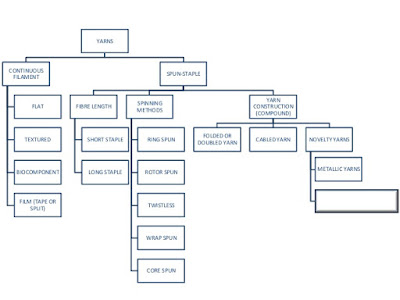 |
| Classification of yarns |
1. Spun yarn
Spun staple fiber yarn consist of staple fibers assembled
and bound together by various means to produce the required characteristics
such as strength, handle, appearance, etc. spun yarns are composed of staple
fibers (short length fibers) twisted or spun into a single thread-like strand.
A high twist is generally needed for the fibers to create a strong yarn.
2. Continues filament yarns
Continues filament yarn are produced by either combining the
required number of filaments together as in the silk throwing process or, more
commonly as in the case of manmade fibers, by producing the required number of
filament and thickness of filaments simultaneously in one spinning operation
Because of the unbroken nature of the fiber, a low twist is
enough to create a smooth and lustrous yarn. The typical filament yarn is,
therefore, a collection of parallel filaments lying close together and
virtually straight running the whole length of the yarn. Yarn with one filament
is referred to as monofilaments and those with more than one as multifilament.
1.Ring spun yarns
Ring spun yarns are produced on the ring and traveler system
from a wide variety of fiber types. This is most popular system of staple fiber
yarn production, being able to utilize a wide range of fiber types, fiber
fitness and fiber length. The component fibers are twisted around each other to
set up frictional forces between the fibers to impart strength to the yarn
2.Rotor spun yarn (open end yarns)
Like ring spun yarns, they consist of fibers bound together
by twist. Rotor spun yarns are generally only produced from short staple
fibers. There are a number of differences in quality between ring and rotor
yarns; in general, rotor yarns are more regular but weaker than comparable ring
spun yarns.
3.Twist less yarn
Twist less yarn are yarns produced from staple fibers where
the consolidation of the fibers is by means of some form of adhesive
4.Wrap spun yarns
Yarns consisting of parallel bundle of staple bound into a
compact structure by another yarn, usually continuous filament. Can be produced
using both long and short staple fibers.
5.Core spun yarns
Core yarns are characterized by having a central core
wrapped with staple fibers. These are produced in a sigle operation by feeding
a yarn through the delivery rollers of a spinning flame, simultaneously with
staple fibers
Core yarns can be produced in three different form such as :
-
Cotton with filament core;
-
Hair fibers with cotton core;
-
Various fibers with electrometric core;
6. Self twist yarns
Self- twist yarns are two ply yarns produced in a single
operation. During manufacture, each component is twisted in alternating directions
in short segments. The two components are subsequently put together in such a
way they twist together (self – twist) to form the final yarn. Self-twist yarns
are predominantly produced from long staple fibers
7. Friction spun yarn
Produced on spinning system which use two rotating rollers
to collect and twist individual fibers into a stable yarn structure.
8. Fascinated yarns
Fascinated yarns are yarns produced from staple fibers where
the consolidation of the fibers is by means of some form of adhesive.





